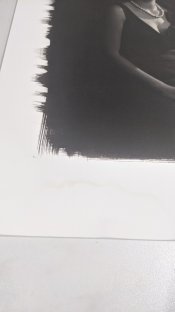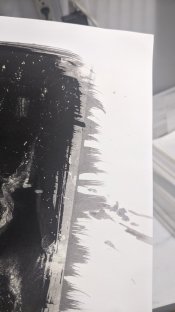Kris Bochenek
Member
- Joined
- Jun 18, 2011
- Messages
- 6
- Format
- Medium Format
Hello,
I am seeking help. I have been doing salt prints for a while and I have settled on a formula that works for me. I use Platinum rag paper and coat it with 2% ammonium chloride and 24% silver nitrate mixed 1:1 with 6% citric acid. I expose, wash, tone, fix in 10% sodium thiosulfate and hypo clear for 5 minutes before washing for about 20 minutes. Here's the issue I have and I think it's related to insufficient wash or hypo clear time. The prints dry nicely, but after few days, they develop like water stains but brown/ yellow. (see attached) these stains correspond with the way the paper was hanging so they are always towards the bottom. From my experience, the past prints had that too but more pronounced staining and since that was before I would hypo clear, I figured that was due to fixer oozing out. Now I use hypo clear and occasionally still get these, not too bad and not all the prints, but still. So what causes that?
I am seeking help. I have been doing salt prints for a while and I have settled on a formula that works for me. I use Platinum rag paper and coat it with 2% ammonium chloride and 24% silver nitrate mixed 1:1 with 6% citric acid. I expose, wash, tone, fix in 10% sodium thiosulfate and hypo clear for 5 minutes before washing for about 20 minutes. Here's the issue I have and I think it's related to insufficient wash or hypo clear time. The prints dry nicely, but after few days, they develop like water stains but brown/ yellow. (see attached) these stains correspond with the way the paper was hanging so they are always towards the bottom. From my experience, the past prints had that too but more pronounced staining and since that was before I would hypo clear, I figured that was due to fixer oozing out. Now I use hypo clear and occasionally still get these, not too bad and not all the prints, but still. So what causes that?




